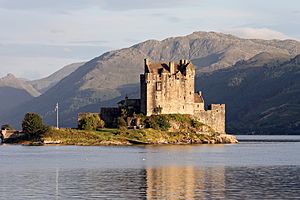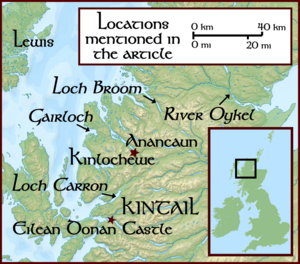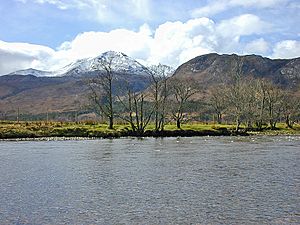Leod Macgilleandrais facts for kids
Quick facts for kids
Leod Macgilleandrais
|
|
|---|---|
| Died | 14th century Feith Leoid, near Kinlochewe
|
| Cause of death | Put to death |
| Children | Paul Mactire (son) |
| Notes | |
|
According to 17th century tradition
|
|
Leod Macgilleandrais was a man from Scotland who lived in the 1300s. We know about him from old family stories, called clan traditions. These stories were written down much later, in the late 1600s.
Leod was a supporter of the Earl of Ross. He was also a rival of the Mackenzies from a place called Kintail. The stories say that Leod captured an early Mackenzie chief. Later, the chief's son killed Leod. This happened sometime in the 14th century. The place where Leod was killed is still known today. Some stories say Leod had a son named Paul. Historians in the 1800s and early 1900s thought this Paul might be Paul Mactire.
Contents
Leod's Story
According to old accounts, a Mackenzie chief named Kenneth lived in the 1200s. He was in charge of Eilean Donan Castle in Kintail. At this time, William I, Earl of Ross was trying to take back control of the area from the Norse people. The Earl wanted Eilean Donan Castle to help his plans. He also felt threatened by Kenneth's growing power.
The Earl demanded that Kenneth give him the castle. But Kenneth refused. Other local clans, like the Macbeolains, Macivors, Mactearlichs, and Macaulays, supported Kenneth. The Earl sent soldiers to take the castle by force. Kenneth and his allies fought them off. The Earl sent more soldiers, but he became sick and died in 1274 before another attack.
Leod and the Mackenzies

Later, during the time of Kenneth, who was the third Mackenzie chief, the lands of Kintail were given to Reginald, son of Roderick of the Isles, in 1342. This was confirmed by King David II two years later.
Around this time, followers of the Earl of Ross attacked the area of Kinlochewe. They stole many things. Kenneth and his men chased them. They got back much of what was stolen and killed many of the attackers. Because of this, one of the Earl's supporters, Leod Macgilleandrais, captured Kenneth. The Mackenzie chief was later executed in Inverness in 1346. His lands in Kinlochewe were then given to Leod for his service to the Earl.
While Kenneth was captured, Eilean Donan Castle was defended by Duncan Macaulay. Duncan owned lands in Loch Broom. After Kenneth's death, the Earl wanted to capture Kenneth's young son, Murdoch. Duncan knew this. He sent his own son and Murdoch to a safe place with Macdougall of Lorn, who was a relative of young Murdoch. The Earl just missed capturing Murdoch. But he did capture Duncan's son. The Earl had Duncan's son killed. This was revenge for Duncan defending Eilean Donan Castle.
Leod's lands in Kinlochewe were between Kintail and Loch Broom. This made it easy for him to attack both areas. But Duncan Macaulay successfully defended Eilean Donan Castle against all of Leod's attacks.
Different Stories of Leod's Death
Many old stories tell how Leod Macgilleandrais died. These stories were passed down through families.
- George Mackenzie, 1st Earl of Cromartie: In the 1600s, the Earl of Cromartie wrote about the Clan Mackenzie. One of his stories says that Macaulay, who was in charge of Eilean Donan Castle, was killed by Leod. Later, Black Murdoch, the Mackenzie chief, got the lands of Loch Broom and Coigeach through his wife, who was Macaulay's daughter. The Earl of Cromartie also wrote that Leod owned lands in Strathcarron and Strathokell.
Cromartie said that Black Murdoch went to his uncle, Macleod of Lewis. He got two large boats and 120 men. They sailed from Lewis to Loch Broom or Loch Carron. Black Murdoch learned that Leod planned a meeting at Kinlochewe. Leod wanted to plan an attack on Eilean Donan Castle. Black Murdoch and his men marched to the meeting place. They ambushed Leod and his friends. Leod was killed for his part in Macaulay's death. This happened at a place called "Achiluask," which was later called "Fe-leod."
- The Ardintoul MS: This old document from the 1600s tells a similar story. It says Black Murdoch secretly stayed with his uncle, Macleod of Lewis. Leod felt safe because he hadn't heard anything about Murdoch. But when the time was right, Black Murdoch got two boats and men from his uncle. They landed at Sanachan in Kishorn and went to Kinlochewe. They found Leod's home in a thick wood.
Murdoch learned that Leod planned to meet people the next morning at a place called 'the ford of the heads'. The next morning, Murdoch and his men waited. When Leod's friends arrived, they were ambushed and many were killed. When Leod and his own men arrived, they were also ambushed. After a short fight, they ran away. Leod and his followers were chased and caught at a place now called 'Leod's bog'. Everyone was killed except Leod's son, Paul. Paul was held captive until he promised not to get revenge for his father. Black Murdoch then gave Leod's widow to a man named Gille Riabhach as a wife. Their descendants have lived in Kinlochewe ever since.
- The Applecross MS: This manuscript from 1667 has a very similar story to the Ardintoul MS. It says Macleod of Lewis gave Black Murdoch men and weapons. They landed at Sanachan in Kishorn. They marched to Kinlochewe. There, they met a sad woman who worked for Leod. She told them Leod was nearby. That night, Leod decided to go hunting the next morning. He told some men to meet him at a specific ford. The woman told Black Murdoch about this meeting place. When Leod's men arrived, they were ambushed. All of them had their heads cut off. This ford has been known as 'the ford of the men's heads' ever since.
When Leod arrived at the ford the next morning, he was also surprised. He fought Black Murdoch for a while but was forced to retreat. He ran towards his house. He was caught in a mire and killed. This place has since been called "Fea leod." Leod's wife and belongings were given to Black Murdoch's trusted friend, Gille Riabhach. Their descendants have lived in Kinlochewe ever since.
- Dr. George Mackenzie: In the early 1700s, Dr. George Mackenzie wrote another account. He said that after the old Mackenzie chief died, Duncan Macaulay of Loch Broom joined the men of Kintail against Leod. He sent the young Mackenzie chief, Murdoch, to safety on Lewis. While Murdoch was away, Duncan's son, also named Murdoch, became the governor of Eilean Donan Castle. Leod often attacked Duncan's lands. In one attack, he killed Duncan. Leod then took control of Loch Broom and Kintail, but the castle still held out. When the Mackenzie chief returned, he killed Leod. Duncan's son, Murdoch, then got back his father's lands. Murdoch had a daughter who married the Mackenzie chief. Through her, the Mackenzies eventually gained the lands of Loch Broom.
Places Connected to Leod
In the late 1800s, John Henry Dixon shared a story about Leod's death. He said that Ath-nan-cean ("the ford of the heads") was where the heads of those killed by Black Murdoch were thrown into the Kinlochewe River. The river carried them to this special ford. This place name is mentioned in the Ardintoul manuscript and the Applecross manuscript. Today, it is known as Anancaun in English and Àth nan Ceann in Scottish Gaelic. It is located at grid reference NH0263.
Dixon also said that the spot where Leod is traditionally said to have died is about three miles from Kinlochewe. It's "on the hill east of the Torridon road." Dixon called it Feith Leoid in Gaelic. He noted that this place is shown on maps. This name is mentioned by Cromartie as "Fe-leod" and in the Ardintoul and Applecross manuscripts as "Fea leod."
Paul Macgilleandrais

The Ardintoul manuscript says that Leod had a son named Paul who survived him. Several historians believe this Paul is the same person as Paul Mactire. Paul Mactire was a well-known freebooter (a kind of adventurer or bandit) in many clan stories.
Paul Mactire appears in official records from the 1360s. He held lands from the Earl of Ross in Easter Ross and Gairloch in Wester Ross. He also appears in a family tree from the 1400s as the chief of Clan Gillanders. However, the name Leod is not mentioned in his family history in that record. It's not clear if Paul Mactire's name means "Paul, son of Tire" or "Paul the wolf." Both meanings are thought to be possible.



